
Speaker:
Ana Lozano-Vivas (with O. Badunenko and S.C. Kumbhakar))
- University of Malaga
Wednesday, January 31, 2018
at
12:30 PM
Polo Santa Marta, Via Cantarane 24, Room 1.59
Although the business model (BM) is the most fundamental task of the bank's management to ensure sustained operation and profitability of a bank, it has become a subject of supervisor's scrutiny due to the recent financial crisis when failing banks were rescued with public funds and supervisors were criticized around the world. Since one of the reasons for the financial crisis was that some banks had (and still have) unsustainable BMs, sustainable BMs are on the top of the ECB’s agenda. Given its relevance, it is important to understand implication that BM characteristics have for bank performance in general and for cost efficiency in particular. Optimizing cost efficiency has become a necessity for the survival of bank. This is one of the top priorities for a bank, especially during times when revenue generating opportunities are suboptimal.
This paper uses the Herfindahl index to measure how concentrate the bank is in items of the asset, funding or income portfolio. We analyze efficiency of bank BM along three business dimensions, viz., assets, funding and income, for the European Banking Industry from 1993-2016. We apply recently developed four components heteroskedastic cost model to investigate effects of three business dimensions to time varying bank cost inefficiency while controlling for bank effects and persistent cost inefficiency. In the proposed model we disentangle persistent and transient cost inefficiency. In particular, we assume that bank‐specific effects and noise terms are homoscedastic but persistent cost inefficiency and time‐varying cost inefficiency (transient cost inefficiency) are made heteroscedastic in terms of assets, funding and income diversification for each bank. Note that we are interpreting heteroscedasticity in terms of BM. Such interpretation abets us to identify which type of bank business model is able to achieve a sustainable bank cost efficient performance. Sustainable cost efficient business model will require that the bank BM enhances persistent cost efficiency and does not deteriorate transient cost efficiency.
- Programme Director
-
Angelo
Zago
-
External reference
-
- Publication date
-
July 20, 2017








